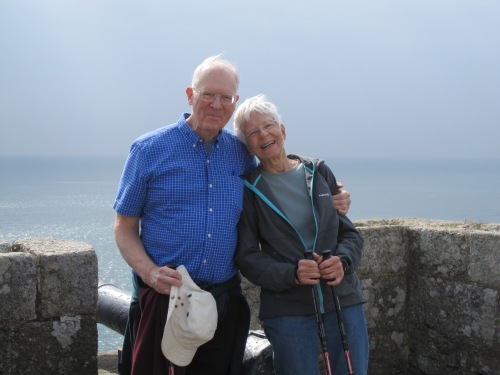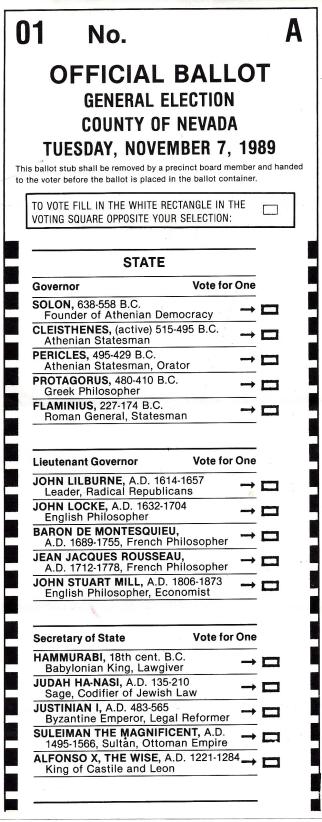Origins of My Escape and Evasion Research
I became involved in researching the subjects of this website because of a combination of things:
- My mother and her family were Belgian refugees in World War I. They fled Belgium for England in 1914, later emigrating to the US. I grew up hearing stories about the family history, including an ancestor who served as an officer in Napoleon’s army during the Battle of Waterloo; a cousin, Ralph Hichens, who served as a top turret gunner and flight engineer on a B-17 during WWII; and another cousin, Arthur Britton, who was the British soldier who arrested Gestapo and SS chief Heinrich Himmler in 1945.
- In 1975 I visited Belgium and The Netherlands for the first time. I used the opportunity to look up my great-uncle, Arthur Schrynemakers, a Dutch national who was living in Brussels. During our visit he showed me a document signed by Gen. Dwight Eisenhower, thanking him for helping rescue Allied airmen. Schrynemakers died not long afterwards, which prevented me from learning more from him. It wasn’t until I retired at the end of 1998 that I began to look into what Schrynemakers had done during the war. By the end of 1999 I had learned that there was a dossier on his Resistance activities at the Belgian WWII archive, CEGES-SOMA. It took another year before I was able to get permission from the Belgian Sûreté to look at it.
- I learned from Schrynemakers’ file that he hid nine people from the Nazis at his home in Brussels, including two Jewish families; two members of the Luc-Marc intelligence line who were on the run from the Geheime Feldpolizei (GFP), the German secret military police; and an American airman, Tom Applewhite, who stayed with him for over a month from November-December 1943.
- By the end of 2000 I had located Tom Applewhite. He had vivid memories of his time with Schrynemakers and his other experiences, from when he was shot down 11 November 1943 to when he reached Gibraltar precisely two months later. For the next six years, until his death in January 2007, I had the pleasure of working with him on his story. That, inevitably, led to my learning about the four escape lines that helped him, (1) the Dutch-run Smit-van der Heijden Line in The Netherlands, (2) the Belgian Service EVA in Brussels, (3) the Belgian-run Comet Line, which moved him from Brussels to San Sebastian, Spain, and (4) the British Embassy in Madrid and Consulate in Seville in which the primary figures were Eustace Formby, the British Vice-Consul for Seville; Robert Griffith Evans, local representative of the MacAndrews Co. in Seville; Evans’ wife May; and Fredrik Nergard, the Norwegian consul. .
- In the course of the research I learned of two organizations with shared interests which I joined: The Air Forces Escape and Evasion Society (AFEES) and the WW2 Escape Lines Memorial Society (ELMS). In 2004 I participated in the ELMS Comete Freedom Trail trek across the Pyrenees. Currently I am webmaster for the AFEES website.
- In January 2020 I donated my escape and evasion files to the McDermott Library at the U.S. Air Force Academy in Colorado Springs, Colorado. A description of the collection appears in the following pdf file: Finding Aid_MS 71-Bolinger, Bruce. The collection is open to the public. The library’s website is at https://www.usafa.edu/facilities/library/ .
Talks Given
I enjoy sharing what I have learned with others and have been available to give talks on the subject.
- One of my talks was “By Trial and Error: The Experience of a Dutch Escape Line in WWII,” at the 19th Biennial Conference of the Association for the Advancement of Dutch-American Studies (AADAS) at Central College in Pella, Iowa, June 6-8, 2013. To view the published version, click here. Other talks on my escape and evasion research were as follows:
- Sept. 20, 2021: “”The Evasion of 2nd Lt. Tom Applewhite, An American Airman in Nazi-Occupied Europe, 11 Nov. 1943-11 Jan., 1944”, a Zoom talk to members of the Sun City Lincoln Hills (SCLH) Genealogy Club. It was recorded and is available on Vimeo at https://vimeo.com/610360413.
- May 20, 2021: “The Evasion of 2nd Lt. Tom Applewhite, An American Airman in Nazi-Occupied Europe, 11 Nov. 1943-11 Jan., 1944”, a Zoom talk to members of the 8th Air Force Historical Society.
- 2020: My “Trial and Error” talk at the monthly meeting of the Sun City Lincoln Hills (SCLH) Genealogy Club, Sept. 14, 2020.
- 2018: “The Evasion of 2nd Lt. Tom Applewhite, An American Airman in Nazi-Occupied Europe, 11 Nov. 1943 – 11 Jan. 1944” before a meeting of the Nevada County Genealogical Society, Nevada City, CA, April 10, 2018.
- 2017: My “Trial and Error” talk at the monthly meeting of the Gray Eagles, Sep. 11, 2017, North Highlands (Sacramento)
- 2017: A talk at the monthly meeting of the Nevada County chapter of the Retired Public Employees Association, Jan. 9, 2017, entitled “Who Was Tina Lindeboom?” on the story behind a plaque in Nevada City honoring Tina Lindeboom for aiding Allied military personnel in WWII.
- 2015: A talk at the June meeting of the Placer County Genealogical Society and another on August 2, 2015 at the Oakland Aviation Museum.
- 2014: A public talk sponsored by Friends of the Nevada County Libraries (June) and talks at meetings of the Nevada County Genealogical Society (August) and the Truckee Rotary Club (November).
- 2013: Nevada County Retired Public Employees Assn.
- 2011-2012: Two talks to history students at Nevada Union High School, Grass Valley, Calif.
- 2009: German-American Club
- 2008: Nevada County Historical Society
- 2007: Nevada County Genealogical Society
- 2005: Sacramento Genealogical Society and Placer County Genealogical Society
- 2004: Nevada County Retired Public Employees Association and Roseville Genealogical Society
- 2003: Nevada County Genealogical Society
- 2002: Women’s Ministry and Daughters of the American Revolution, both of Nevada County
From 1980-1998 I served as Nevada County Clerk-Recorder. That position included responsibility for managing all elections—federal, state, and local–held in Nevada County, a small county in Northern California located roughly midway between Sacramento and Reno. Other duties included serving as Ex-Officio Clerk of the Superior Court and the Recorder duties of maintaining all records of land transactions. I was originally appointed Clerk-Recorder by the Nevada County Board of Supervisors to fill a vacancy. Thereafter I ran for election to the office successfully four times. During this same period I was president of the Nevada County Historical Society and the Nevada County Genealogical Society.
As County Clerk-Recorder, occasionally I was able to combine my interests in history, politics, and elections. California law at the time required that voters at the polling place be provided with a demonstration ballot that would help them understand how to cast a vote for someone, but using candidate names that had no connection to the election. Bored with the unimaginative names that we had been using until then, I devised one that would be more interesting:
My prior experience includes, among other things:
- District Manager, 1980 Decennial Census for the U.S. Census Bureau, 1979-1980.
- Consultant to the California Legislature on election legislation, 1975-1979.
- Legislative Assistant to a Member of Congress, 1973-1975.
- Political science instructor and lecturer at two state universities and three community colleges 1965-1972.
- Member, Los Angeles County Charter Revision Committee, 1961. Appointed by the Los Angeles County Board of Supervisors. The committee was directed to review the lengthy county charter and produce a comprehensive revision. I served on the subcommittee specializing in charter provisions affecting county employees.
- Vice-Chairman, Los Angeles County Election Devices Committee, 1966-68. Appointed by the Los Angeles County Board of Supervisors. The committee was directed by the Supervisors to study all the voting systems in use in the United States, evaluate the bids, and recommend one for adoption by the county to replace its system of hand-counting paper ballots. The committee’s recommendation was adopted by the Board.
Education
- M.A., Political Science, University of California at Los Angeles, 1960. Pi Sigma Alpha.
- B.A., Government, Pomona College, 1958. Phi Beta Kappa.
Publications
Escape and Evasion:
- “Belgian Heroism – WWII Escape Lines for Allied Fliers,” Belgian Laces, a publication of The Belgian Researchers, vol. 25 (2003), issues 95 and 96.
- “By Trial and Error: The Experience of a Dutch Escape Line in the Second World War,” in Dutch Americans and War: United States and Abroad, edited by Robert P. Swierenga, Nella Kennedy, and Lisa Zylstra, 177-199, Holland, MI: Van Raalte Press, 2014. (Papers from the Nineteenth Biennial Conference of the Association for the Advancement of Dutch-American Studies, Central College, Pella, Iowa, 6-8 June 2013.) To view “By Trial and Error,” click here.
- “Tom Applewhite, de studenten en de ondergang van de vluchtlijn,” Tussen Paradijs en Toekomst, no. 67, Oktober 2004. (An abbreviated version of this article appeared as “De ontsnapping van Tom Applewhite” in Jonker, Jacob, “De Marechaussee en de Pilotenlijnen,” Museumbrochure nr. 26, Marechausseemuseum, Buren, The Netherlands.)
- “Tom got to freedom, the hard way,” Summer 2007 Communications, The Air Forces Escape and Evasion Society, vol. 19, no.2, June 8, 2007.
- “Who Was Tina Lindeboom?”, Fall 2017 Communications, The Air Forces Escape and Evasion Society, vol. 29, No. 1, November 2017.
Elections and Politics:
- “Ballot Designations for Fun and Profit,” California Journal, VIII (Jan., 1977), 29-30. To view the article, click California Journal Ballot Designations article.
- “California Adopts Ballot Order Rule,” National Civic Review, LXIV (Nov., 1975), 529.
- “California Court Rules on Ballot Order,” National Civic Review, LXIV (October, 1975), 467-468.
- “California Election Law During the Sixties and Seventies: Liberalization and Centralization,” West’s Annotated California Codes, 28C (1977), 55-136. To view the entire article, click on the following pdf file: California Election Law, full article. It will take a few moments to load. Reproduction of the article on this website is with the permission of Thomson Reuters Corporation.
- “Ending of Ballot Favoritism and What It Means,” California Journal, Vol. VI (September, 1975), 306. To view the article, click on the following pdf file: Ending Ballot Favoritism.
- “Political Behavior of Issei and Nisei,” Pacific Citizen, LXVII (December, 1968), 2-11.
- Additional articles appeared in the National Civic Review and other publications.
Family
My wife, Charlotte, and I have lived in Nevada City and then Grass Valley, California for the last 40 years. Thanks to her I have three step-daughters and three grandchildren. (The photo below was taken in Cornwall, Sept. 2014.) My sister, Ann, lives in Aberdeen, Scotland. She and her husband, Derrick, have three sons and four grandchildren. My father was Dwight Bolinger, a professor of Spanish and linguistics. His bibliography is to be found at http://www.dwightbolinger.net/.
My sister, Ann, lives in Aberdeen, Scotland. She and her husband, Derrick, have three sons and four grandchildren. My father was Dwight Bolinger, a professor of Spanish and linguistics. His bibliography is to be found at http://www.dwightbolinger.net/.
Contact Information
For information on how to contact me , click here.

